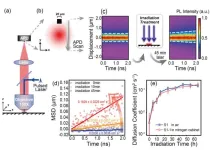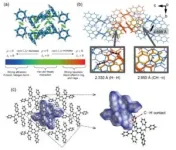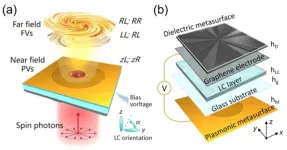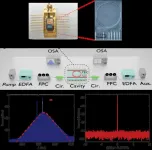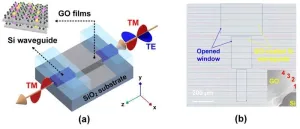A new publication from Opto-Electronic Advances; 10.29026/oea.2025.240207, discusses how light boosts exciton transport in organic molecular crystal.
Organic semiconductors, composed of organic molecules or polymers, offer advantages such as low cost, flexibility, lightweight design, and tunable structural-functional properties. They have significant applications in OLED displays (e.g., smartphones, TVs), organic photovoltaic cells (flexible solar panels), and flexible sensors. In organic semiconductors, excitons—carriers of excited-state energy—play a critical role in photoelectric conversion and energy transfer. Thus, the transport capability of excitons greatly influences the performance of organic semiconductor optoelectronic devices. Unfortunately, compared to inorganic semiconductors, exciton transport in organic semiconductors is generally less efficient, posing a bottleneck for improving device performance. Enhancing exciton transport and developing organic semiconductor materials with superior transport properties is therefore crucial.
Previous studies have focused on chemical synthesis to design new material systems with improved transport characteristics, yielding notable achievements. For example, high-quality nanostructures synthesized via self-assembly have demonstrated efficient exciton transport in isolated systems. However, isolated nanostructures are unsuitable for practical device applications, and transport parameters, such as diffusion coefficient exceeding 1 cm2 s-1, are often measured on ultrafast timescales (tens of picoseconds), which may not reflect sustained exciton transport efficiency under equilibrium conditions over their lifetime. Thus, achieving persistent, efficient exciton transport in device-relevant material systems remains challenging.
Considering that the structure of a material determines its properties, chemically synthesizing different materials is naturally the most direct way to alter the structure. Besides this, is it possible to explore other methods to modify the structure of organic semiconductors in order to more effectively enhance exciton transport properties?
A collaborative team led by Prof. Hongbo Sun and Assoc. Prof. Honghua Fang from Tsinghua University’s Department of Precision Instruments, and Prof. Bin Xu from Jilin University’s College of Chemistry, has achieved a breakthrough in enhancing exciton transport by modifying organic molecular crystal structures via light irradiation.
Using transient photoluminescence-microscopy, the team characterized exciton transport in organic molecular crystal of 2,2’-(2,5-bis(2,2-diphenylvinyl)-1,4-phenylene) dinaphthalene (BDVPN). Through iterative irradiation and characterization, they observed a progressive enhancement of exciton transport: the diffusion coefficient increased by three orders of magnitude (from ~10-3 cm2 s-1 to over 1 cm2 s-1), and the diffusion length extended from below 50 nm to nearly 1 µm. Environmental factors during irradiation were systematically ruled out, confirming that the improvement stems from structural changes in the BDVPN molecular crystal under light exposure. Key structural features of BDVPN—such as its twisted, rotationally flexible molecular framework and intermolecular C–H···π and H···H interactions—facilitate light-induced structural reorganization while maintaining stacking order.
Notably, both laser and cost-effective incoherent LED irradiation induced this enhancement, with the improved transport properties persisting for months. This demonstrates the feasibility and practicality of post-synthesis irradiation treatments for optimizing exciton transport. Future work will focus on resolving the structural modifications induced by irradiation and elucidating their mechanistic link to transport enhancement—a critical step for extending this approach to broader material systems.
Keywords: organic semiconductor / enhanced transport properties / exciton diffusion / time-resolved photoluminescence microscopy
# # # # # #
Hong-Bo Sun is a full professor in the Department of Precision Instruments at Tsinghua University. He received both his B.S. and Ph.D. degrees in electronics from Jilin University, China, in 1992 and 1996, respectively. In 2004, he was promoted as a full professor (Changjiang Scholar) at Jilin University, and since 2017 he has been working at Tsinghua University, China. His research interests include ultrafast laser and nanophotonics. He is a fellow of IEEE, OSA, SPIE, and COS. His research interests have been focused on ultrafast optoelectronics, particularly on laser nanofabrication and ultrafast spectroscopy—fabrication of various micro-optical, microelectronical, micromechanical, microoptoelectronic, microfluidic components, and their integrated systems at nanoscale—and exploring ultrafast dynamics of photons, electrons, phonons, and surface plasmons in solar cells, organic light-emitting devices, and low-dimensional quantum systems at femtosecond timescale.
Hong-Hua Fang is an Associate Professor in the Department of Precision Instrument at Tsinghua University since 2019. He completed his Bachelor's degree in 2006 and Master's degree in 2009 from Jilin University. In 2013, he received his Ph.D. in Microelectronics and Solid State Electronics from the same university. After that, he worked at the University of Groningen in the Netherlands as a postdoc and later at the Institut National des Sciences Appliquées in Toulouse, France, where he was part of the Laboratory of Physics and Chemistry of Nano-Objects. In 2019, he joined Tsinghua University as a faculty member. His research focuses on laser processes and optoelectronic properties of quantum materials, as well as their applications in photonics and optoelectronic devices. He has authored and co-authored over 100 papers in peer-reviewed journals such as Science Advances, Nature Communications, Physical Review Letter and Laser Photonics Review.
Bin Xu is a Professor at the State Key Laboratory of Supramolecular Structure and Materials, College of Chemistry, Jilin University, and holds the title of Tang Aoqing Scholar Distinguished Professor. Prof. Xu's research focuses on organic luminescent materials based on molecular aggregates, aiming to develop highly efficient and multifunctional luminescent materials through the rational design of molecular structures and precise control of aggregate structures. He has published over 190 research papers in international peer-viewed journals such as J. Am. Chem. Soc., Angew. Chem. Int. Ed., Adv. Mater., and CCS Chemistry, with over 11000 citations (H-index:57.
# # # # # #
Opto-Electronic Advances (OEA) is a rapidly growing high-impact, open access, peer reviewed monthly SCI journal with an impact factor of 15.3 (Journal Citation Reports for IF2023). Since its launch in March 2018, OEA has been indexed in SCI, EI, DOAJ, Scopus, CA and ICI databases over the time, and expanded its Editorial Board to 34 members from 17 countries.
# # # # # #
More information: http://www.oejournal.org/oea
Editorial Board: http://www.oejournal.org/oea/editorialboard/list
All issues available in the online archive (http://www.oejournal.org/oea/archive).
Submissions to OEA may be made using ScholarOne (https://mc03.manuscriptcentral.com/oea).
ISSN: 2096-4579
CN: 51-1781/TN
Contact Us: oea@ioe.ac.cn
Twitter: @OptoElectronAdv (https://twitter.com/OptoElectronAdv?lang=en)
WeChat: OE_Journal
# # # # # #
Li XZ, Dai ST, et al. Light-induced enhancement of exciton transport in organic molecular crystal. Opto-Electron Adv 8, 240207 (2025). doi: 10.29026/oea.2025.240207
END
